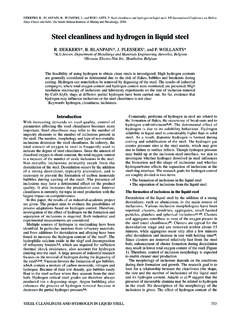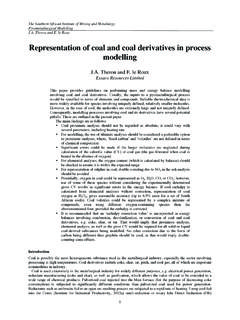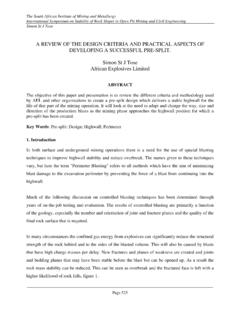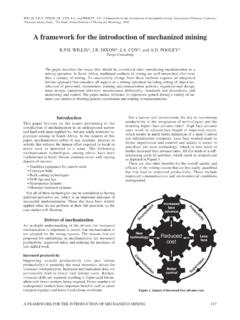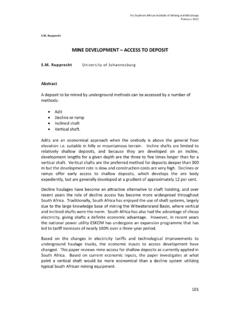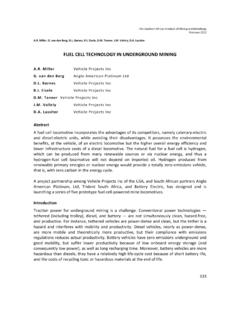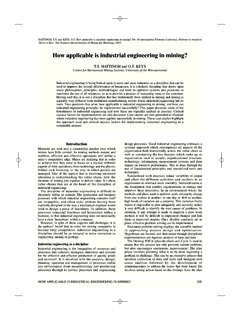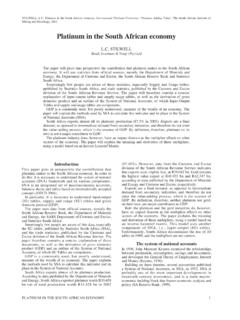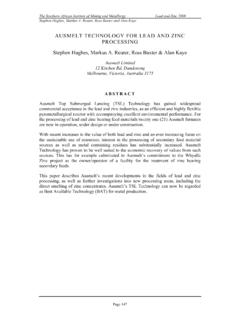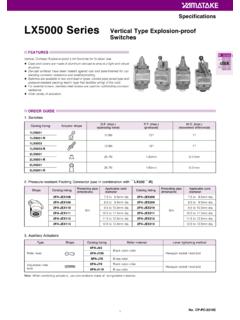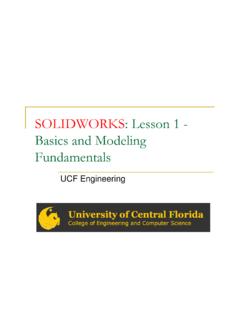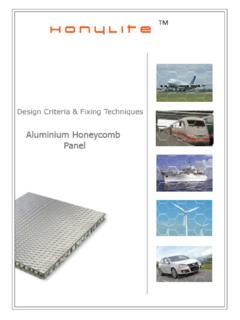Transcription of MECHANISED MINE DEVELOPMENT UTILISING …
1 The South African Institute of Mining and Metallurgy The Third Southern African Conference onBase MetalsPete H Ferreira_____Page 297 MECHANISED MINE DEVELOPMENT UTILISING ROCK CUTTINGAND BORING THROUGH RAISE AND BLIND BORINGTECHNIQUESP H Ferreira Murray & Roberts CementationSYNOPSISThe mechanisation of mine DEVELOPMENT is becoming increasingly important in ourSouth African and Southern African mines with increased emphasis on safe andefficient , blind and shaft boring offer MECHANISED solutions for excavations such as:- reef raises stope boxholes and shaft ore passes ventilation passes and shafts chairlifts large vertical hoisting shafts (in excess of 1200 metres in depth) angled hoisting shafts (from small to large diameter bored holes) These techniques will be discussed with reference to relevant applications and theauthor s comparison between conventional drill and blast OF CONTENTS1.
2 INTRODUCTION2. CURRENT TECHNIQUESFLAT DIPPING TO STEEPER DIPPING TUNNELLING Drill and blast MECHANISED tunnelling and Drop Alimak or mono rail type Conventional vertical shaft Rock cutting and Raise Blind boringThe South African Institute of Mining and Metallurgy The Third Southern African Conference onBase MetalsPete H Ferreira_____Page Shaft boring3. COMPARISON OF DRILL & BLAST TECHNIQUES4. FUTURE CHALLENGES5. SAFETY ASPECTS6. CONCLUSION7. ACKNOWLEDGEMENTS8. of safety, economy, availability of skilled labour, as well as internationalcompetition emphasize the need for MECHANISED mine mechanisation suited to the circumstances at hand should beconsidered when selecting an excavation includes mechanized drill, blast, support and cleaning methods,generally for flat to 10 inclined or declined excavations in Southern Africanmines, with special methods and equipment for steeper inclined/declinedexcavations.
3 A drill and blast method offers greater flexibility than raise andblind boring techniques although each has its own pro s and con TECHNIQUESFLAT DIPPING TO STEEP DIPPING TUNNELLING and blast MECHANISED tunnelling and Drop raisingDrop raising, also known as longhole raise blasting or upsidedown raising ,is an excavation which is completely pre-drilled over its full length, thencharged from the top, or bottom, and finally blasted from the bottom in practicallengths for an effective advance per South African Institute of Mining and Metallurgy The Third Southern African Conference onBase MetalsPete H Ferreira_____Page 299 Drop raising is commonly used world-wide in the DEVELOPMENT of rock andventilation passes over a length of generally up to 60m in the vertical mode andaround 15m in an almost flat mode (Refer graph 1 and 2 Inclination and lengthmatrix).
4 Drop raising offers a safe method of excavation at relatively economic advantages of this method include not exposing people to the dangers ofentering a pass from underneath, and, the ability to blast short passes of up to10m in one additional important advantages are:-SafetyThe raise needs never to be entered once blastingcommences, thus hazards posed by falls of ground,fumes, poor working conditions etc. are of the raise is much faster than handheldoperations. Once drilling has been completed,blasting can take place without the interruptions ofmaking safe and drilling the next inside of the raise does not need to be equipped;thereby eliminating that safety and speed result in early availabilityof the of Dropraise vs InclinationDown Drilling605550454035300102030405060 Metres90807060504030 DegreesGraph 1 Length of Dropraise vs InclinationUp Drilling3532292623211805101520253035 Metres90807060504030 DegreesGraph 2 The South African Institute of Mining and Metallurgy The Third Southern African Conference onBase MetalsPete H Ferreira_____Page 300 Figure Alimak or mono-rail raisingAlimak raising makes use of a rack and pinion type system for the transportationof people into a pass with normal drill and blast methods.
5 This method is widelyused in Canada but has not found much favour in South is a relatively fast method and can be used in excavations in excess of 200m inlength. A further advantage is that support components can be installed as Alimak method offers solutions in the DEVELOPMENT of reef raises, boxholes,ventilation passes, shafts, etc. at practical diameters ranging from 1,8m to Conventional vertical shaft sinkingConventional vertical blind shaft sinking using drill and blast techniques hasbeen practised for as long as underground mining has taken shaft sinking methods are being used:- Handheld drilling of the bottom with a nominal metre advance perblast Jumbo drilling of the bottom using either pneumatic or electro-hydraulicdrifters with advance per blast of up to metres Mucking with an Eimco 630 type loader into a kibble Mucking with a cryderman type clam system into a kibble Mucking with a cactus grab type lashing unit into a kibble Concurrent shaft concrete lining from the sinking stage Drop Raise DrillrigThe South African Institute of Mining and Metallurgy The Third Southern African Conference onBase MetalsPete H Ferreira_____Page 301 Rock is hoisted to surface or the bank elevation, not interfering therefore withother rock hoisting operations.
6 Bottom access becomes unnecessary. This, then,is the appropriate method where a shaft is sunk in green fields winding facilities are usually required to hoist the rock from the shaftbottom. A large stage winder installation is hence, a given, especially withcactus grab are frequently equipped, on completion of a sink, to shaft bottom, unless acryderman type cleaning method is used; which supports concurrent equippingof a shaft with the sinking. A smaller stage winder is necessary in this sink operations are generally done when sinking shafts of metres indiameter and more. Advances per blast will vary and advances per day willaverage around metres to metres, depending on the depth of shaft and deepest one lift blind vertical shaft sunk to date has been the South Deepshaft in South Africa to a depth of some 2 991 metres below sink shafts can be sunk from very shallow to very deep, and to anydiameter, depending on the cutting and Raise boringRaise boring has been commonly used in the mining industry since 1968 for themechanical cutting of excavations to various diameters and lengths, rangingfrom 0,7m in diameter to 7,1m and up to 1260m in & Roberts Cementation has been involved in raise boring contractingsince 1978 and has become the world s largest raise boring contractor.
7 Murray& Roberts Cementation is considered a leader in the field of large diameter raiseboring. The company operates a total of 41 raise drills, which include 4 WirthHG 330 SP type machines; these being some of the largest raise drills evermanufactured in the world. This fleet has been extended to include one 123R, aswell as two 103R borers can be used in various modes of operation, the modes most oftenused are:- Conventional pilot drilling Conventional upreaming of vertical and inclined holes Down boring with a pre-drilled pilot hole Blind up boringThe South African Institute of Mining and Metallurgy The Third Southern African Conference onBase MetalsPete H Ferreira_____Page 302 Directional piloting and raise boring used in conjunction with a shaftboring machine (V-mole), for the drilling and support of a large Up-reaming of Pilot HolesOn completion of pilot drilling; and at such time as the pilot hole breaks lowerexcavation.
8 A reaming head is fitted to the end of the drill string, rotated andreamed back. The size of the reaming heads range between 0,7 metres and 7,1metre in is a safe, efficient and cost-effective method of making holes through differentgeological formations using powerful machines, high strength drill string andreliable heads. The maximum loading capacity of the drill string determines thediameter as well as the length of the shaft. The loading is dynamic and onlyapproximately calculable because tensile, torsional and bending stresses Figure 2 Figure 2 Down Boring with a Pre-drilled pilot holeIn this case an oversized pilot hole is drilled. The cutting head is installed at thetop of the pilot hole and drilling takes place in the downward mode.
9 Rockcuttings are flushed down the oversized pilot hole to the bottom of the holewhere they are removed. In the case of smaller holes, cutter thrust is providedby the machine and in the case of large diameter shafts, the cutter head isweighted through the addition of steel collars. The down boring method is notoften used as the risk of blocking the pilot hole and creating mud rushes at thebottom of the hole is too Figure 3 The South African Institute of Mining and Metallurgy The Third Southern African Conference onBase MetalsPete H Ferreira_____Page 303 Figure 3 Directional Pilot DrillingDirectional pilot drilling is costly and therefore only used in instances where ahigh degree of accuracy is required. The accuracy of a vertical pilot hole can beguaranteed to depths within the capability of the raise drill machine andaccuracies of 0,036% have regularly been achieved improvement made in directional drilling, now enables hoisting shafts to beraise drilled, either in one pass or in combination with the 1 typically quantifies the capabilities of the various raise bore machinescommonly available in the boring is more and more becoming an economical means of excavatingsmall to large holes with great benefits over increased Achievements :-Murray & Roberts Cementation currently holds world records and can boast thefollowing achievements.
10 - Largest diameter shaft raise drilled to metres in diameter and 178metres of vertical depth at Sasol Coal s Secunda Collieries BosjespruitMine. (See Figure 4)The South African Institute of Mining and Metallurgy The Third Southern African Conference onBase MetalsPete H Ferreira_____Page 304 Figure 4 ( Metre Reamer Head) Longest vertical hole reamed to metres in diameter and 1260 metresdeep at the Prismulde Project, Germany. At Kloof Gold Mine South Africa, a 1 100 metre deep, metre diameterhole was drilled through the hardest lava rock formation with an UCSbetween 600 and 750 Mpa. Longest inclined raise drilled hole to metres in diameter and 755 metresdeep at BCL in Botswana. Deepest shaft V-mole bored in South Africa to metres in diameter and972 metres deep at Oryx Gold Mine.
